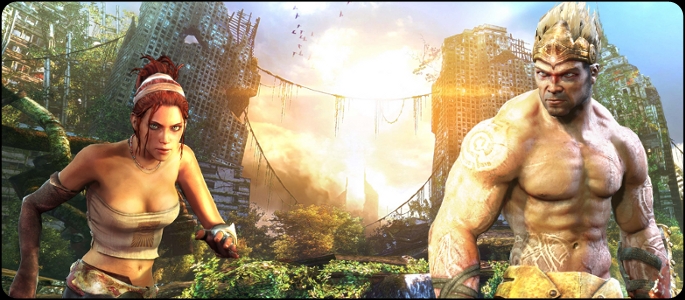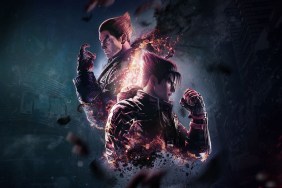When most people hear about a post-apocalyptic setting, images of vast gray wastelands are probably the first of many things that come to mind. These bleak backdrops would have been created due to some world war among humans where nuclear weapons played a role in their extinction, leaving nothing but desolation. In Enslaved: Odyssey to the West, developer Ninja Theory throws out most of those common conventions, and ushers in a much more vibrant take on the world after its destruction, told through a classic and old Chinese tale. This is one story that is sure to captivate you from beginning to end.
Enslaved’s story starts us off in the future, where only a remnant of mankind has survived from what seems to be an atrocious attack by their own design: attack mechs. While the history of this future isn’t exactly told in detail, we do catch clues of what may have happened during some of the exchanged dialogue as the game progresses. Our place in the story begins with Monkey and Trip, who are both captive on board a slave trading vessel. After they make their escape, Trip wires a slave band onto Monkey’s noggin after he was knocked unconscious during their flee. The head band has now “enslaved” Monkey to Trip, who now needs his help to get home. If Monkey disobeys Trip’s commands or lets her die, then Monkey will likewise perish. From here, an unlikely adventure begins.
One of the first things you’ll recognize about Enslaved is that it is very green and lush with vegetation – quite pretty for a post-apocalyptic setting. Nature has reclaimed what man has built, and the level designs really pull off that earthy and semi-organic feel. Each level feels as if it’s been completely abandoned by mankind, only to be ruled by nature and the mechanized life that patrol the territories. Since Monkey and Trip seem to be the only living humans in the dangerous lands, you may quickly feel a sense of dependency on each other to survive, even though they may have started off on the wrong foot from the beginning.
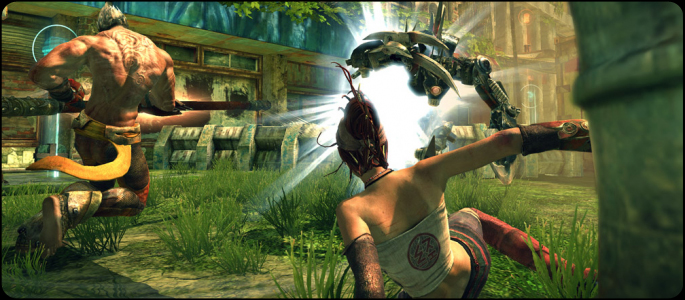
Filling the role of Monkey, you’ll slowly begin to learn how he and Trip work together in a semi-symbiotic relationship. As Trip’s “slave”, you’ll protect her from the mechs and help her access places out of reach when she commands you. Even though Monkey is made of brawn and grit, you’ll frequently call upon Trip’s help too, such as her ability to distract enemies while you maneuver yourself into an advantageous position for take downs. She will also be essential to Monkey for doling out health vials and providing much needed upgrades to his gear.
Thanks to the great script penned by Alex Garland and the voice-overs by Andy Serkis and Lindsay Shaw, the dialogue builds such an incredible dynamic between the two characters that is life-like and believable. Even the facial animations provide such strong emotional feedback during the silent pauses in the cut scenes. Watching the scenes play out has an uncanny realism, closely bridging the gap between big-budget films and motion-captured game sequences. The level of care put towards those scenes makes the adventure all the more captivating, drawing upon your curiosity to push the experience forward, something that isn’t easily achievable by most games.
Another element that will draw you into the game is the music. The orchestral pieces composed by Nitin Sawhney captures the emotion on the screen, whether during a cutscene or during the gameplay. During the particularly intense action sequences, the music picks up a powerful pace, then rolls off into soft ambient tones after the combat is completed, and continues during the platforming elements. The sound effects are also superbly implemented throughout the game, giving each moving object a sense of weight and purpose. However, there were a few rare instances of sound glitches when an action or voice dialogue didn’t register. The glitch wasn’t big enough of a deal to remove me from being immersed in the rich atmosphere.
Though the cutscenes really shine visually, the graphics during gameplay are impressive as well. Many times, you’ll be caught off guard with amazing panoramic views of vast landscapes that are gorgeously adorned with green life and foliage. As you progress through the game, you’ll be visiting many unique locations – from abandoned cities full of nature to desolate landscapes littered with scrap metal. However, as eye-catching the levels may seem to be, there doesn’t seem to be a consistency with the amount of amazing detail. Sometimes, you’ll notice objects that were given sharp textures, and in that same setting there will be another item sporting a muddy coat of paint, as if someone forgot to give it attention. The frame rate will also stutter from time-to-time during some of the larger set-pieces, but the visuals will typically run smooth during most of your journey. Such nuances are small and infrequent, but anyone with critical eye may find it distracting.
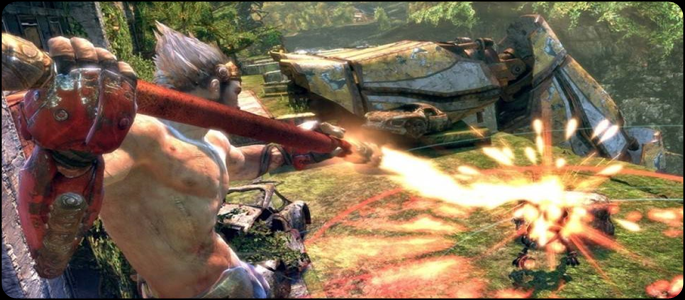
Animations are fluid and add to the believability of both the humans and the mechs. Performing actions whether in battle or scaling a wall seem to have a sense of natural movement. There are some instances though, where you’ll need to perform contextual actions with Trip, which involve hoisting her up to an out-of-reach ledge or flinging her across a wide gap. Here, the animations look like they could have used some work, as the action you’ll see is exactly the same every time and doesn’t carry the same fluidity of other animations. It definitely would have been nice to see some more animated variety in that area, but even that small issue isn’t enough to completely break the overall experience.
Enslaved also utilizes platforming elements that are very reminiscent from the likes of Uncharted. However, the difficulty involved to climb and jump from ledge-to-ledge is quite forgiving and simplistic. Rarely (if ever) will Monkey fall to his death from a jumping sequence. Each leap while scaling a wall, or lunging out to a frail beam will connect every time. Even if you were to try to force Monkey off a cliff, it would prove to be impossible. If a jump action isn’t possible in a certain direction, Monkey would simply hesitate or shake his head, indicating that the move isn’t able to be performed. However, as you progress through the game, the challenge involved with the platforming elements is slightly increased. Yes, you still won’t fall, but you will now have to correctly time your jumps to avoid receiving damage or death, depending on the environment that you’re traversing.
The combat sequences are extremely fun and brutal. The control layout for fighting against the mechs are similar (if not the same) to Ninja Theory’s debut title, Heavenly Sword. Your main combat buttons rely solely on the ‘square’ and ‘triangle’ buttons, and then ‘circle’ for a counterattack while in a guard using ‘R2.’ With Monkey’s staff, you’ll also be able to perform ranged attacks on the mechs. At first, the mechanics for fighting are simple, requiring not much skill to reduce your adversaries into a metal paper weight. Further down the campaign, you’ll encounter a few more variety of mechs where your beginner tactics won’t aide your survival. You’ll be required to employ newer strategies when defending against a group of 3 or more if you intend to keep Monkey and Trip alive.
In some areas, you’ll have to find cover from gunfire behind small stacks of brick that will collapse one piece at a time if it absorbs too much heat. Situations like that will require you to constantly think on your feet while you devise a strategy before losing all of your means for cover. Once you’ve figured out the timing of each different melee attack of the mechs, it will become much easier to dispatch them and move on to the next group.
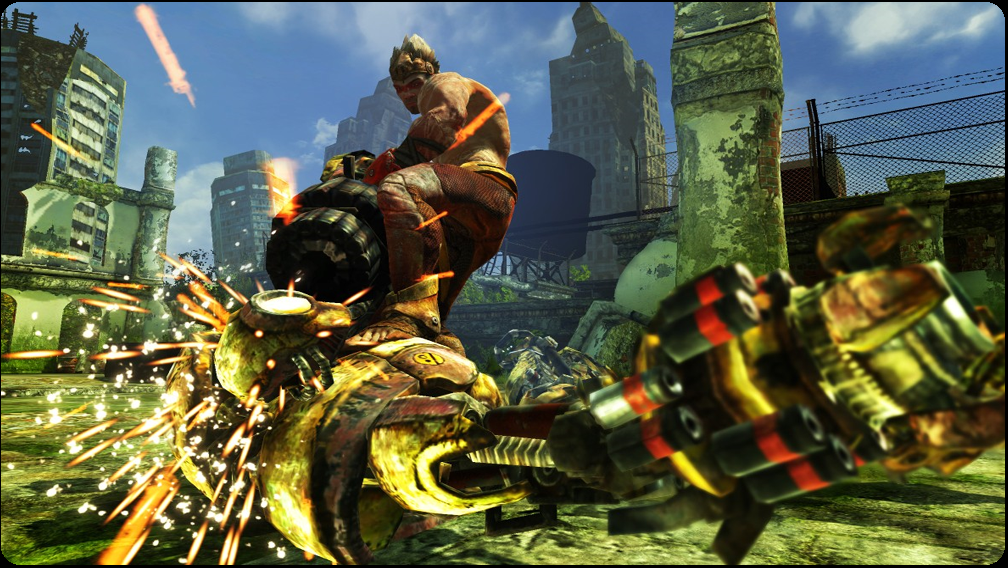
Occasionally, during a brawl you’ll be prompted with an option to perform a take down with the push of a button. Performing these ruthless actions can be quite satisfying to watch, but strangely doesn’t require a button mini-game after enacting the sequence. Rather, you just watch Monkey tear apart the mech in glorious fashion, which isn’t a bad thing either. I just think it would’ve been more immersive to include a sequence of button prompts to make the player feel like they are in control while ripping the mech into oblivion. Regardless of that missing element, the take down sequences feel great to execute, especially when unleashing the deadly moves during some of the memorable boss battles.
With Enslaved, you will find it really easy to lose track of time, since the pacing of the story has been choreographed extremely well. The game seldom keeps you yawning as you’ll always find yourself wanting to progress the story to unlock its mysteries. New surprises seem to be waiting around each corner, which help keep the game fresh during the entire twelve-hour experience.
In spite of the few glitches and minor graphic issues, Enslaved is one of those games that is hard to put down once you get captivated by its compelling story and memorable characters. The depth of gameplay is satisfying for any level of gamer – it’s not too deep nor is it overly complicated to chase away the curiosity of those new to the genre. The story, although not new, is definitely unique and is fresh to the industry. Even with its flaws, anyone brave enough to take on this journey will not find this adventure disappointing.
PlayStation LifeStyle’s Final Score
+ Captivating Story and Top-notch voice acting + Solid pacing and Immersive experience – Few sound glitches and visual inconsistencies |
 |
–
